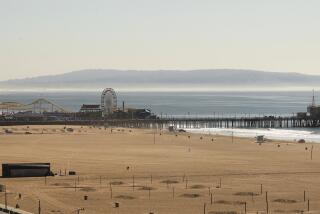U.S. Questions Beach Transfer : Environment: Federal officials raise concerns that sensitive coastal areas would not be adequately protected if they are overseen by county instead of state.
- Share via
Federal authorities have expressed serious reservations about a proposed transfer of eight state-owned beaches to Los Angeles County, maintaining that the county possesses neither the expertise nor the desire to preserve precious coastal resources.
Federal park authorities have notified the state in writing and have met with California officials recently to express their concerns and to urge caution in relinquishing control of a vast stretch of Santa Monica Bay coastal lands that constitute some of the most vital natural resources and preserves in the state.
In an April 17 letter from the National Park Service to the California Department of Parks and Recreation, federal officials asked to be included in discussions because “these state beaches are especially significant as accessible, protected remnants along a heavily developed and visited coastline.”
“Regardless of who owns or operates these vital coastal parklands, it is critical that they receive the equivalent level of resource protection and compliance afforded under state or national park ownership,” wrote Stanley T. Albright, Western regional director of the National Park Service.
Albright also pointed out in the letter that the congressionally authorized boundary for the Santa Monica Mountains National Recreation Area encompasses the beaches in question and noted that several of the state beaches were purchased with federal grant money that restricts their use and transfer.
“We have identified several resource management issues we felt should be of concern to the state in any proposed transfer,” said Scott Erickson, acting superintendent of the national recreation area.
Erickson cited the tidal pools at Leo Carrillo and Zuma beaches and the Malibu Lagoon as examples of areas that require the kind of delicate shepherding that has been a staple of state stewardship but that might be neglected under county control.
State officials had also been concerned with the issue, specifying in the initial transfer proposal that Malibu Lagoon be exempted. But Erickson cited other problematic aspects of the county’s maintenance efforts on the beaches--haphazard storage practices, castaway dumpsters--as having raised concerns.
He said that in one instance county officials removed the nesting site of a shorebird known as a plover to improve public access.
County officials disputed assertions that they have neglected the beaches.
“It irritates me that we are getting questioned on this,” said Ken Johnson, a spokesman for the county Department of Beaches and Harbors. “I think one of the most pristine beaches around is the county-owned Nicholas Canyon. I don’t think anyone can question our stewardship or how we’ve kept that up.”
But federal authorities apparently remain unconvinced. Erickson said he has offered the state federal resources, such as equipment and even cashiers for parking operations, to assist in assuming full lifeguard and beach maintenance responsibilities.
The federal involvement comes at the end of long period of increasingly fractious squabbling over who should pay for lifeguard and maintenance services.
The county has controlled operation of maintenance crews and lifeguard patrols at state and city-owned beaches since the 1970s, in order to bring uniformity to what had been a patchwork of services.
It has grown increasingly insistent, however, that the state and beach cities should increase their share of maintenance costs. Service costs at all of the state beaches--including Manhattan, Redondo, Point Dume, Dan Blocker, Malibu Surfrider, Las Tunas, Topanga and Royal Palms--amount to $4.3 million annually, with the state contributing only minimally for upkeep.
The county has continued to negotiate over the issue, demanding in its latest proposal that the state provide a long-term subsidy to the county to run the beaches. It has given the state until Tuesday to come to terms.
The state countered by offering to give the beaches to the county, claiming that due to its weak financial condition, it cannot afford to share in the costs of operating the beaches without severely hampering other critical state park services. It had proposed giving the county about $4.3 million over the next three years but has balked at a long-term reimbursement.
More to Read
Sign up for Essential California
The most important California stories and recommendations in your inbox every morning.
You may occasionally receive promotional content from the Los Angeles Times.










